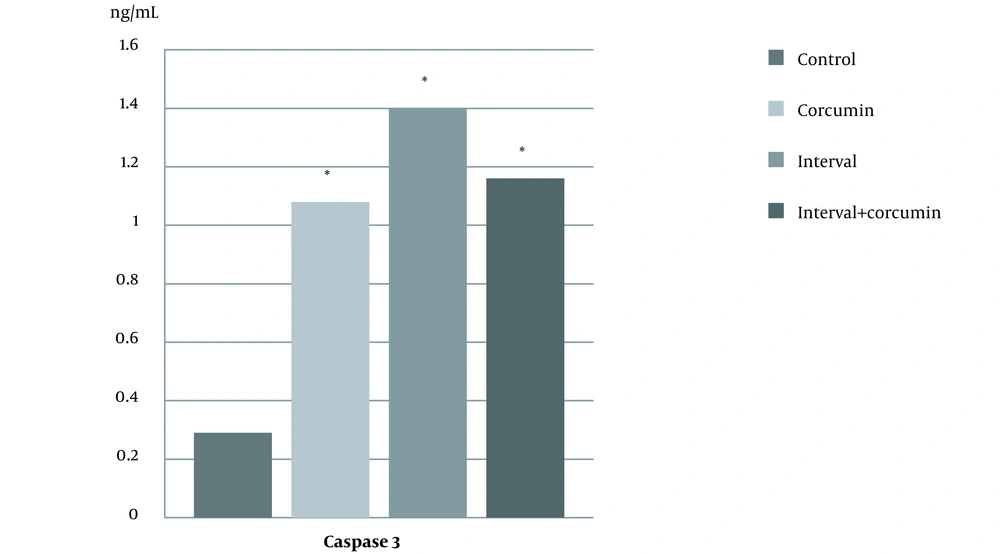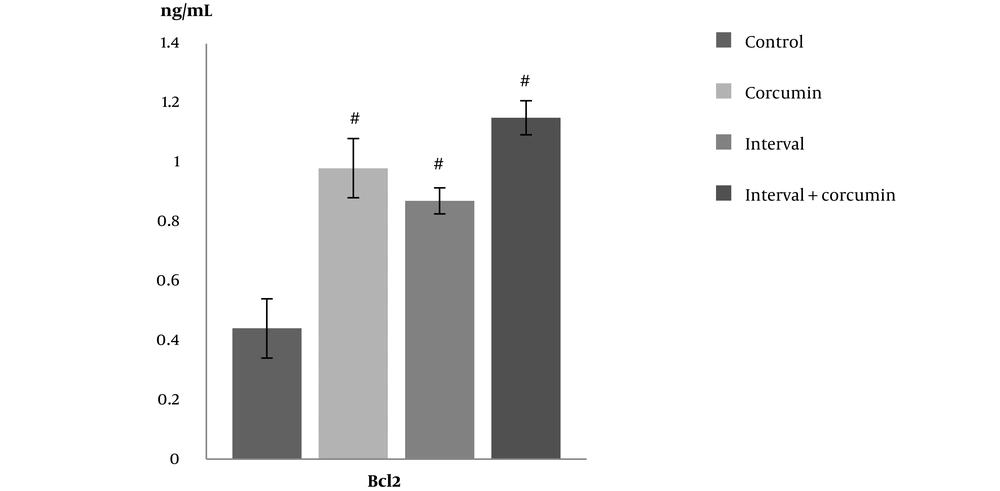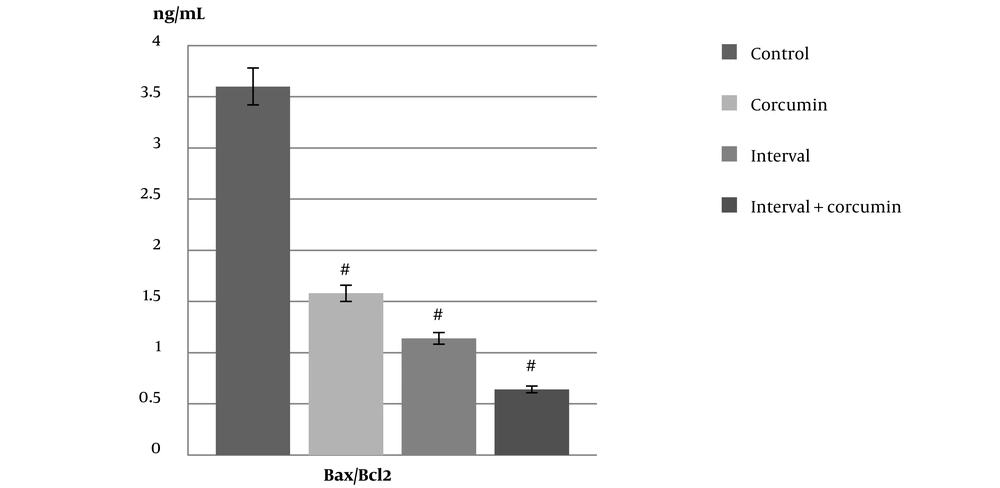1. Background
Apoptosis is one of the main ways of cell homeostasis in the body that occurs under the control of different genes in multicellular and unicellular organisms (1). Bcl-associated X (BAX) protein and B-cell lymphoma 2 (Bcl-2) protein are significant in forming mitochondrial apoptotic channels. Caspase protease enzymes, including caspase-3 and 7, are also involved in various apoptotic pathways (2).
Curcumin is a polyphenol used as a painkiller, anti-inflammatory agent, and a source of powerful antioxidants. Numerous studies have confirmed the biological effects of curcumin and introduced it into various pathological conditions (3). It contains many anti-diabetic, anti-tumor, anti-inflammatory, and antioxidant agents (4). Curcumin activates the caspase-3 enzyme and releases cytochrome c from the mitochondria to the cytosol (5). Also, curcumin can improve athletic performance and delay exercise fatigue (6). Studies have shown that curcumin synergizes with 5-fluorouracil and enhances apoptosis in cancer cells in xenograft mice (7). If curcumin enters cancer cells, it activates programmed cell death pathways.
Exercise is another critical factor in promoting health and fighting planned cell death. The simultaneous physiological and immunological effects of curcumin and physical activity have been less studied. Regular exercise can reduce the apoptosis rate in healthy people (8). The impact of interval training on the expression of myocardial infarction and leukemia inhibitory factor (LIF) in skeletal muscle atrophy rats showed that Bcl-2/BAX increased in the interval training group and decreased in the sedentary group (9). Aerobic activity may reduce the signal of mitochondrial apoptosis in the heart muscle by increasing Bcl-2 protein and BAX/Bcl-2 ratio. The BAX protein reduction in mitochondria and the cytochrome c accumulation in the cytosol have also been observed (10). Some studies have shown that cardiac receptors associated with the obesity-associated apoptosis pathway are activated by exercise. Mitochondrial pathway-dependent apoptosis also decreases with an increase in Bcl-2 and a decrease in BAX and caspase-9 (11). The effects of endurance training on caspase-3 and 9 proteins have been investigated in the tumor tissue of rats with breast cancer (12).
The curcumin consumption at doses of 150 - 1500 mg per day before and during exercise and up to 72 h after exercise could reduce the inflammation caused by physical activity and improve performance. In addition, it appears that humans can tolerate high doses of curcumin without side effects (13). Also, curcumin reduced muscle pain compared to the placebo and decreased post-exercise inflammatory responses without adverse effects. However, it has been reported not to affect TAC, TNF-α, and MDA. Research on curcumin and its mechanical effects on muscle recovery have not yet been performed (14). Nevertheless, the effects of curcumin on inflammatory factors, muscle injury, and exercise training have been investigated in sedentary individuals (15).
2. Objectives
The role of curcumin and other supplements has been investigated in apoptosis and its indicators. Most research on curcumin and exercise has been conducted in the recovery period, focusing on inflammatory, oxidative, cancer, and human factors. However, this study addresses the simultaneous effects of curcumin supplementation and intense interval training, as the physiological changes caused by physical activity can affect the immune system. The antioxidant effects of curcumin are another intervention. Therefore, this study aimed to investigate the effects of intense interval training and curcumin consumption on some indicators of apoptosis and caspase-3 in female rats.
3. Methods
3.1. Groups
In this experimental study, the statistical population included 45 elderly female Wistar rats. Rats were obtained from the Pasteur Institute and housed in the University Laboratory Animal House. Then, 28 mice were randomly selected as a statistical sample. Rats were randomly divided into four groups (control, high-intensity interval training, curcumin, and high-intensity interval training + curcumin). Water was freely available in a 500 ml bottle for the laboratory animals (16). Rats were kept in separate polycarbonate cages with 20 × 27 × 47 cm dimensions. The ambient temperature was set at 22 ± 1.4°C, the light cycle at 12:12 h, and the humidity at 55 ± 0.6%. Rats were fed with foods produced by the Pars-Iran Company Animal Feed Production Center. Also, the water required for each animal was provided in 500 mL bottles for laboratory animals. All research stages were carried out as per the ethical principles of working with animals.
3.2. Exercise Protocol
The training groups were adapted to a rodent treadmill for one week before the start of the protocol (17). The training groups were trained five minutes per day for five days before starting the research protocol to get acquainted with the treadmill. The training program consisted of three sessions per week for six weeks. Each session comprised 10 sets of one-minute activity with 75% intensity for the HIIT group (High-intensity interval training) and two minutes of rest between sets, which started at a speed of 14 meters per minute in the first week. In the following weeks, 2 meters per minute was added to the speed. Until it reached a maximum of 28 meters per minute in the eighth week. Also, five minutes before and after the training, the animals were provided with warming and cooling.
3.3. Supplementation
Curcumin (25 mg) was given to the curcumin and curcumin-training groups by gavage three days a week (18). Eight weeks after the study, all animals with the same conditions followed 13 h fasting, and 48 h after the last training session, they were anesthetized by intraperitoneal injection of ketamine and xylosine to take a sample of heart tissue. The tissue levels of variables were measured using the Western blot method (19).
3.4. Tissue Sampling and Laboratory Measurements
Six weeks after the study, all rats with the same conditions, after 13 hours of fasting and 48 hours of the last training session, were anesthetized with ketamine (60 mg per kg body weight) and xylosine (5 mg per kg body weight) intra-peritoneal with a ratio of 5 to 2. Samples of heart tissue were taken and frozen at -70°C. The tissue levels of variables were measured using the Western blot method (19). We first cut the heart tissue into small pieces in Western blot analysis and homogenized them. This step was performed in the Radio Immunoprecipitation Assay and a protease inhibitor buffer (phenyl-methyl-sulfonyl fluoride) (complete cocktail tablet, Roche Applied Science, Mannheim, Germany). The supernatant was collected using centrifugation at 12,000 rpm for 20 min. Protein concentrations were determined using BCA (bicinchoninic acid), a protein assay kit. The isolated protein was loaded and isolated by SDS polyacrylamide gel electrophoresis (sodium dodecyl sulfate), and dissolved proteins were transferred to PVDF (polyvinyl difluoride) membranes. The membranes were blocked with 5% skim milk in tris buffer salt and incubated at 4°C overnight with different primary antibodies. After washing three times with Tween-20 saline buffer, the membranes were proportional to the secondary antibodies (1:12,000) and incubated for 1.5 h.
The next step was to measure changes in BAX, Bcl-2, caspase-3 enzyme activity, and BAX/Bcl-2 ratio. Devices were used to process the data and indicate whether the cells underwent apoptosis or not.
3.5. Statistical Analysis
The normal distribution of data was assessed using the Shapiro-Wilk test, and the homogeneity of variances using the Levin test. Significant changes in variables were determined using ANOVA and the Tukey post hoc test (P ≤ 0.05).
4. Results
Mean changes in caspase-3, BAX, and Bcl-2 protein expression were determined as the mean and standard deviation. The Shapiro-Wilk test was normal. The Leven test confirmed the homogeneity of variances.
The results showed that caspase-3 had the highest increase in the intense interval training and intense interval training + curcumin groups. One-way ANOVA evaluated the difference between the mean caspase-3 values. According to the test results, the expression of caspase-3 protein was significantly different between the groups. The Tukey post hoc test confirmed a significant increase in the three experimental groups compared to the control group (Figure 1).
The results showed that BAX had the highest increase in the intense interval training + curcumin and intense interval training groups. One-way ANOVA (P = 0.001) evaluated changes in BAX protein expression. According to the test results, the BAX protein expression was significantly different between the groups. Tukey post hoc test confirmed a significant decrease in exercise + curcumin and curcumin groups compared with the control and exercise groups. (Figure 2).
The results showed that Bcl-2 had the highest increase in the intense interval training and intense interval training + curcumin groups. One-way ANOVA (P = 0.002) evaluated the differences between the means of Bcl-2. According to the test results, the Bcl-2 protein expression was significantly different between the groups. The Tukey post hoc test confirmed a significant increase between the experimental groups compared to the control group. (Figure 3).
The results showed that the BAX to Bcl-2 ratio had the highest decrease in the intense interval training + curcumin and intense interval training groups. The ratio of BAX to Bcl-2 was significantly different between the groups. The Tukey post hoc test confirmed the significant difference between all groups and the control group (Figure 4).
5. Discussion
The results showed that the expression of BAX pro-apoptotic protein decreased in the interval training-curcumin supplement and curcumin supplement groups, but the anti-apoptotic protein Bcl-2 increased. This study showed that HIIT was an essential factor in the induction of apoptosis, and the expression of Bax, Bcl-2, and caspase-3 increased during HIIT. The ratio of BAX to Bcl-2 was lower in the supplement + exercise group than in the other groups, indicating a direct effect of the two independent variables. The ratio of BAX to Bcl-2 decreased. Apoptosis limits tissue damage and induces direct signals for adaptation induced by mediators such as reactive oxygen species, cytokines, and hormones.
Exercise creates physiological stress and induces adaptive responses. This confirms the decrease in apoptosis in the exercise + curcumin supplement group. Physical activity stimulates the apoptotic pathways and affects the balance between the release of free radicals and the antioxidant defense mechanism. Reactive oxygen species also affect apoptotic pathways. However, training and curcumin reduced this interaction. One of the possibilities of these changes is the direct prevention of apoptosis due to exercise protocol and curcumin supplementation. Interval training and supplementation can increase heart rate and blood lactate threshold level, improve body composition, and decrease fat percentage. Also, increased stimulation of the sarcoplasmic reticulum and contractile pumps in the mitochondrial membrane makes molecular changes, consistent with the results of Siddighi's research. Maintaining homeostasis and oxidative compatibility can reduce apoptosis. Of course, Sedighi et al. used endurance training to assess cardiac apoptosis. The tissue studied and the length of the training period are the reasons for the similarity of the results of the two studies (20). Exercise duration and curcumin use can significantly increase Bcl-2 and BAX levels and the BAX/ Bcl-2 ratio depending on the exercise intensity.
In addition, the combination of exercise and curcumin had an antagonistic effect. Chiu and Su studied breast cancer and apoptotic agents and obtained different results (21). The study of Safarzadeh Gargari et al. also showed that the expression of proteins and their ratio were not significantly different from the control group. In their study, hydrogen peroxide injection into the tissue was much stronger than endurance training, and apoptosis was not stopped (22). In the study of Karimi et al., the expression of BAX and Bcl-2 genes did not change significantly, but caspase-3 activity showed a significant increase in the liver of diabetic rats before and after treatment with aqueous garlic extract. The discrepancy between the results seems to be due to the use of garlic supplements and sampled tissue (23, 24). The main reason for the alignment of the results is the direct and potential impact of exercise and matched texture.
Severe oxidative stress destabilizes mitochondrial membrane homeostasis, stimulates the formation of permeable pores of mitochondrial membranes, and releases pre-apoptotic agents such as cytochrome c. Exercise can have the opposite effect and reduce pro-apoptotic genes by increasing antioxidant capacity and modulating stress (25). Intense exercise triggers an inflammatory response, and taking supplements can be effective too. Intense activity, unlike moderate aerobic activity, causes DNA to fragment and caspase cascades to begin (26). Flavonoid and cerebroside compounds in curcumin supplementation can reduce these effects. In this study, HIIT reduced the expression of pro-apoptotic genes by increasing antioxidant capacity and modulating oxidative stress (14). Therefore, training and curcumin supplementation prevented the increase of caspase-3 expression, while apoptosis was reduced due to the compatibility of training and supplementation.
5.1. Conclusions
High-intensity interval training did not affect reducing BAX protein. However, training and curcumin supplementation increased the expression of Bcl-2 protein, and this ratio has been able to reduce the effect of BAX. Therefore, curcumin supplementation and intermittent exercise can reduce cell apoptosis and programmed cell death.



